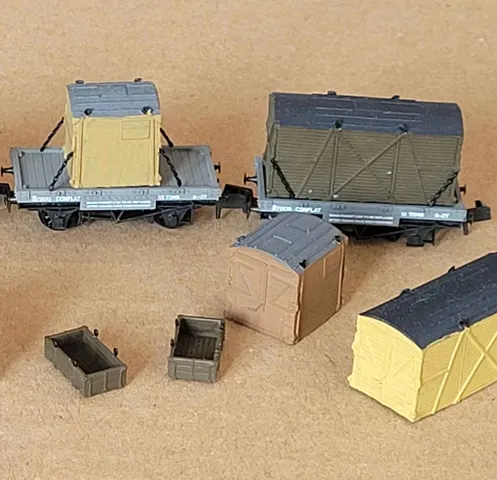
OIT - UK rail container (1-148)
prusaprinters
Nowadays everything is shipped around the world in containers. But not many people are aware, that the history of “containerisation” or “intermodal transport” started far back in the late 19th century in UK, shortly after the modern railway became more common. A good historical overview on this can be found here:https://igg.org.uk/rail/5-unit/unitload1.htmhttps://www.brightontoymuseum.co.uk/index/Category:Shipping_containersSince a longer time I liked to recreate this part of transport history in n-scale, but available models in this scale are not much, so I started to fill up the gaps. Step by step I will upload the models here and of course the first step is concerning the containers itself.You will find following containers:Type A - in two versions (one with wooden back end and one with pressed steel end) – this is 7’6”-standard container. Graham Farish offers similar and more modern versions: https://www.bachmann.co.uk/product/category/164/type-a-containers-br-bauxite-%28x2%29-and-type-af-cont-br-ice-blue-%28x2%29/379-392Type B - is the bigger 16’-funiture container with door on one end only, this model is quite similar to the PECO-model:https://peco-uk.com/collections/2mm-n/products/lms-furniture-removals-pack-of-2Type BD – is the later and more common version of the B-type with doors at sides as well. This container type is also offered by Graham Farish:https://www.bachmann.co.uk/product/category/164/type-bd-containers-br-bauxite-%28x2%29-and-br-crimson-%28x2%29/379-393Type BK – is a version of BD-container made of plywood panels instead of T&G-boards. According to some sources this is also a furniture container, other sources seem to suggest it was used as insulated box.Type H – is an open bulk container, probably closest to the very first kind of containers, ever used. It is to transport bulk cargo or construction material (for last one I made brick sheets as cargo). It seems, that this container is modelled for the very first time, at least in n-scale.There is a nice picture of these containers in use – you may find here:https://heritagemachines.com/commercials/fascinating-road-rail-story/All my DIY-containers are compatible with both Peco-wagons and the Graham Farish ones:https://peco-uk.com/collections/2mm-n/products/sr-furniture-removals-conflat-wagon-with-containerhttps://www.bachmann.co.uk/product/category/163/conflat-wagon-br-bauxite-%28early%29-with-2-br-white-af-containers-%5bw%2c-wl%5d/377-340bhttps://www.bachmann.co.uk/product/category/163/3-plank-wagon-lms-grey/377-502bIn respect to the P-type conflate announced by Rapido Trains UK I will check as soon as available:https://www.keymodelworld.com/article/rapido-trains-uk-conflat-p-nFor more realistic view on wagons there are versions of A/B-type containers with lashing chains.Models should by quite correct as I found not only photos, but also original drawings of the containers here:https://paulbartlett.zenfolio.com/acontainerhttps://paulbartlett.zenfolio.com/brhodcontainerhttps://hmrs.org.uk/drawings.html?subject_subdivision=68For painting and liveries the following sources might be helpful:https://igg.org.uk/rail/6-livy/lms/9-lms.htmhttp://www.robbiesrollingstock.co.uk/Containers.htmAll models sized for British n-scale (1:148).Conversion values:Continental N-scale, 1:160 -> 92.5%TT-gauge, 1:120 -> 123%HO/H0-gauge, 1:87 -> 170%OO/00-gauge, 1:76 -> 195%
With this file you will be able to print OIT - UK rail container (1-148) with your 3D printer. Click on the button and save the file on your computer to work, edit or customize your design. You can also find more 3D designs for printers on OIT - UK rail container (1-148).
